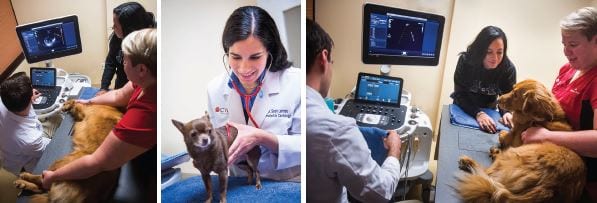The Duty of Ultrasound and CT Check in Modern Vet Practices: Insights From Experienced Professionals
In modern veterinary practices, ultrasound and CT scans greatly improve diagnostic capacities. These imaging methods give important insights right into animal health and wellness, leading treatment choices. Experienced professionals identify the one-of-a-kind advantages of each technique. Ultrasound offers real-time analyses, while CT checks provide detailed physiological details. Recognizing their applications and duties increases vital concerns about their effect on client end results and the future of vet diagnostics. What understandings can be gotten from their combined usage?
Recognizing Ultrasound in Vet Medication
Ultrasound is an essential analysis device in vet medicine, providing a non-invasive method to imagine inner structures. This imaging strategy uses high-frequency acoustic waves to develop real-time photos of cells and organs, permitting vets to evaluate problems without surgical treatment. Common applications consist of examining the heart, liver, kidneys, and reproductive body organs, along with monitoring pregnancies.The treatment is fairly quick and can be done in numerous setups, making it an easily accessible choice for vets. Unlike radiography, ultrasound provides detailed information regarding soft cells and blood circulation, which is vital for exact diagnoses.Veterinary specialists depend on ultrasound to spot irregularities such as lumps, cysts, and fluid accumulation. Its ability to lead biopsies and other procedures better enhances its utility in professional practice. By providing a risk-free and efficient way to analyze internal composition, ultrasound has actually come to be a cornerstone of modern vet diagnostics.
The Advantages of CT Checks for Pet Diagnostics
CT scans offer substantial benefits in veterinary diagnostics by offering boosted accuracy in determining internal conditions (Cancer Veterinary Near Me). As a non-invasive imaging method, they guarantee the safety and security and convenience of animals during evaluations. Additionally, CT checks assist in an extensive evaluation of interior structures, permitting much more reliable treatment planning
Enhanced Diagnostic Accuracy
Developments in imaging modern technology have significantly improved analysis precision in veterinary medicine, particularly through using CT scans. These scans give comprehensive cross-sectional images of a pet's internal structures, allowing vets to identify abnormalities with accuracy. The high resolution and three-dimensional capacities of CT imaging assist in the discovery of conditions such as tumors, fractures, and interior bleeding that may be missed with traditional imaging techniques. Furthermore, CT scans can help in pre-surgical planning by supplying a complete sight of physiological connections. This level of detail not just boosts the precision of diagnoses but additionally aids in tailoring effective treatment strategies. As a result, the assimilation of CT innovation right into vet practices is transforming the landscape of pet healthcare, enhancing results for clients.
Non-Invasive Imaging Technique
The intro of non-invasive imaging methods has actually reinvented pet diagnostics, with CT scans becoming a popular tool in veterinary practices. These scans give high-resolution, cross-sectional photos of a pet's inner frameworks, permitting veterinarians to evaluate intricate problems without the demand for invasive procedures. The benefits of CT scans include their capability to spot tumors, cracks, and inner blood loss with amazing precision. In addition, they facilitate the analysis of soft cells and body organs, improving analysis capabilities. The rate of CT scanning enables fast decision-making, which is important in emergency circumstances. By minimizing stress and pain for the pet, CT scans contribute to a more humane strategy to diagnostics, ultimately improving treatment results and advancing veterinary care.
Comprehensive Internal Analysis
An extensive interior assessment is essential for exact diagnosis and effective treatment in vet medication. CT scans deal substantial advantages hereof, providing thorough cross-sectional photos of an animal's internal frameworks. This advanced imaging method enhances visualization of complex anatomical areas, making it possible for vets to determine problems such as tumors, fractures, and interior blood loss with greater accuracy. In addition, CT scans help with the evaluation of conditions that may be testing to detect with conventional techniques. The rate and accuracy of CT imaging likewise add to timely interventions, enhancing client results. As veterinary techniques significantly incorporate CT innovation, the benefits of comprehensive inner analyses come to be evident, strengthening the relevance of this device in contemporary vet diagnostics.
Comparing Ultrasound and CT Imaging Techniques
While both ultrasound and CT imaging offer necessary functions in vet diagnostics, each strategy uses distinctive advantages and constraints that can affect professional decision-making. Ultrasound is particularly valued for its real-time imaging abilities, enabling veterinarians to observe dynamic physical processes. This technique is non-invasive, portable, and does not include ionizing radiation, making it a much safer alternative for both pets and medical professionals. Nonetheless, ultrasound may have restrictions in imagining particular anatomical structures or deep tissues.Conversely, CT imaging gives detailed cross-sectional views of the body, permitting exact localization of problems. It excels in assessing facility body organs and frameworks, especially in the thorax and abdominal area. Nonetheless, CT scans require sedation or anesthesia in a lot of cases and include exposure to ionizing radiation. Inevitably, the choice in between ultrasound and CT depends on the particular useful source medical scenario, the area of passion, and the necessity of the analysis needs.
Situation Studies: Successful Medical Diagnoses Through Imaging
Case research studies show the significant enhancements in analysis accuracy accomplished through sophisticated imaging modern technologies like ultrasound and CT scans in vet practices. These innovations not just boost the detection of different conditions but additionally facilitate prompt and effective therapy plans. Assessing particular instances can highlight the transformative influence of these imaging strategies on veterinary medication.
Analysis Precision Improvements

Imaging Modern Technology Advancements
As veterinary imaging modern technology continues to progress, its influence on diagnostic abilities comes to be increasingly apparent. Recent study highlight the successful application of innovative ultrasound and CT scan strategies in recognizing complex problems. A veterinary facility utilized high-resolution CT scans have a peek at this website to detect an uncommon kind of lung cancer in a dog, which traditional imaging had actually missed out on. Similarly, an ultrasound evaluation revealed an abdominal mass in a pet cat, prompting prompt surgical treatment and a favorable end result. These improvements not just boost analysis accuracy but also make it possible for veterinarians to devise targeted treatment strategies. By leveraging sophisticated imaging innovations, veterinary specialists are noticeably enhancing individual treatment, leading to extra reliable management of different health and wellness problems in animals.
The Role of Imaging in Emergency Situation Vet Treatment
Imaging plays a vital duty in emergency veterinary care, providing vets with essential info needed to make rapid, educated decisions. In urgent circumstances, methods like ultrasound and CT scans enable specialists to quickly assess a pet dog's inner structures, recognizing important problems such as internal blood loss, fractures, or body organ abnormalities. These imaging techniques enable real-time examinations, facilitating timely treatments that can be life-saving. Ultrasound is vital for assessing soft cells injuries and problems like fluid accumulation, while CT checks offer detailed photos of complicated physiological structures, necessary for identifying trauma cases. The rate and precision of these imaging methods improve the vet's capability to devise effective treatment strategies, ensuring the most effective possible results for their patients. As a result, the combination of sophisticated imaging innovations into emergency situation vet techniques is not only useful yet progressively required, as it enhances analysis capabilities and boosts general animal care during crucial minutes.
Training and Knowledge in Vet Imaging
Advanced imaging methods such as ultrasound and CT scans are crucial for effective vet care, the successful implementation of these technologies heavily depends on the training and experience of veterinary specialists. Skilled use of imaging tools needs complete understanding of composition, pathology, and the principles underlying each modality. Veterinary professionals have to undergo specific training to properly interpret imaging results, which is crucial for detecting problems and intending treatment.Certifications and proceeding education and learning in vet imaging boost the abilities of specialists, allowing them to remain updated with technical advancements. Partnership in between veterinarians and radiologists commonly brings about boosted diagnostic accuracy, as specialists can supply insights into complicated instances. On top of that, functional experience in handling imaging devices cultivates confidence in its application. Ultimately, the quality of vet imaging services is straight correlated to the level of training and proficiency had by the professionals utilizing these necessary diagnostic devices.
Future Fads in Diagnostic Imaging for Animals
With the quick innovations in technology, veterinary diagnostic imaging is positioned for substantial evolution in the coming years. Emerging fads show a change towards even more easily accessible and portable imaging modalities, such as handheld ultrasound devices, which can boost area diagnostics. Read Full Report Additionally, the assimilation of fabricated knowledge is expected to revolutionize photo analysis, enabling for quicker and more exact interpretations of results.Moreover, advancements in 3D imaging strategies and calculated tomography will give veterinarians with more comprehensive views of pet composition, causing improved therapy strategies. Online fact innovation may likewise contribute in medical planning and education, giving vets a distinct viewpoint on complicated cases.As telemedicine remains to grow, remote consultations promoted by diagnostic imaging will certainly become extra common, permitting specialists to help family doctors in real-time. In general, these fads are set to boost the efficiency and performance of veterinary treatment, ultimately boosting pet results.
Regularly Asked Concerns
Just How Much Do Ultrasound and CT Scans Price in Veterinary Facilities?
The costs of ultrasound and CT scans in veterinary facilities normally range from $300 to $1,500, depending upon variables such as location, center kind, and details procedures required for the pet's diagnosis and treatment.

Exist Any Type Of Threats Connected With Ultrasound and CT Checks for Animals?
Ultrasound and CT scans generally pose marginal dangers to animals. However, potential problems include sedation reactions and direct exposure to anesthetics. Cancer Veterinary Near Me. Veterinarians carefully assess each instance to minimize any type of risks connected with these diagnostic treatments
How Lengthy Do Ultrasound and CT Procedures Typically Take?
Ultrasound treatments typically take around 30 minutes to an hour, relying on the complexity. CT scans, being even more comprehensive, generally require 30 mins to 90 minutes, consisting of prep work and recovery time for the family pet.
Can All Veterinarians Perform Ultrasounds and CT Scans?
Not all vets can carry out ultrasounds and CT scans. Specialized training and qualification are typically called for to guarantee expertise in these advanced imaging methods, which might restrict their availability to veterinarians with added qualifications and resources.
What Kinds of Animals Benefit The Majority Of From These Imaging Techniques?
Certain pet species, specifically canines and pet cats, benefit considerably from ultrasound and CT scans. These imaging strategies enhance diagnostic accuracy for problems like growths, interior injuries, and body organ problems, leading to improved treatment outcomes and person treatment. The high resolution and three-dimensional abilities of CT imaging promote the discovery of problems such as growths, cracks, and inner bleeding that might be missed with conventional imaging techniques. Situation research studies show the substantial enhancements in diagnostic precision accomplished with sophisticated imaging modern technologies like ultrasound and CT scans in vet techniques. Improving analysis accuracy in veterinary practices has been significantly assisted by advancements in imaging technologies such as ultrasound and CT scans. Advanced imaging techniques such as ultrasound and CT scans are essential for effective vet treatment, the successful execution of these technologies heavily depends on the training and proficiency of veterinary professionals. Vet specialists have to undertake specific training to properly analyze imaging outcomes, which is crucial for identifying conditions and preparing treatment.Certifications and continuing education and learning in vet imaging enhance the abilities of specialists, allowing them to remain upgraded with technical improvements.